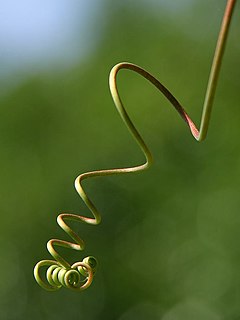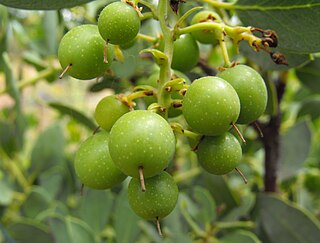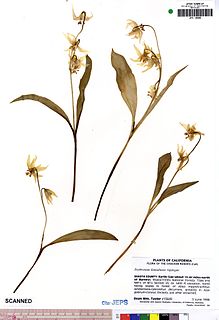| Smilax jamesii | |
|---|---|
 | |
| herbarium specimen [1] | |
| Scientific classification | |
| Kingdom: | Plantae |
| Clade: | Angiosperms |
| Clade: | Monocots |
| Order: | Liliales |
| Family: | Smilacaceae |
| Genus: | Smilax |
| Species: | S. jamesii |
| Binomial name | |
| Smilax jamesii G.Wallace | |
Smilax jamesii is a species of flowering plant in the greenbriar family known by the common name English Peak greenbriar. [2] It is to northern California, where it is known from the Klamath Mountains and the southernmost peaks of the Cascade Range. It has also been reported from nearby locations in southwestern Oregon. [3] [4] [5] It grows in moist areas such as lakesides and streambanks in mountain coniferous forest habitat. It was discovered to be a new species when herbarium specimens thought to be Smilax californica were reexamined. [6]

Smilacaceae, the greenbrier family, is a family of flowering plants. Up to some decades ago the genera now included in family Smilacaceae were often assigned to a more broadly defined family Liliaceae, but for the past twenty to thirty years most botanists have accepted Smilacaceae as a distinct family. It is considered that the two families diverged around 55 millions years ago during the Early Paleogene possibly near the boundary between Paleocene and Eocene. One characteristic that distinguishes Smilacaceae from most of the other members of the Liliaceae-like Liliales is that it has true vessels in its conducting tissue. Another is that the veins of the leaves, between major veins, are reticulate (net-shaped), rather than parallel as in most monocots.

California is a state in the Pacific Region of the United States. With 39.6 million residents, California is the most populous U.S. state and the third-largest by area. The state capital is Sacramento. The Greater Los Angeles Area and the San Francisco Bay Area are the nation's second and fifth most populous urban regions, with 18.7 million and 8.8 million residents respectively. Los Angeles is California's most populous city, and the country's second most populous, after New York. California also has the nation's most populous county, Los Angeles County, and its largest county by area, San Bernardino County. The City and County of San Francisco is both the country's second-most densely populated major city after New York and the fifth-most densely populated county, behind only four of the five New York City boroughs.

The Klamath Mountains are a rugged and lightly populated mountain range in northwestern California and southwestern Oregon in the western United States. They have a varied geology, with substantial areas of serpentinite and marble, and a climate characterized by moderately cold winters with very heavy snowfall and warm, very dry summers with limited rainfall, especially in the south. As a consequence of the geology and soil types, the mountains harbor several endemic or near-endemic trees, forming one of the largest collections of conifers in the world. The mountains are also home to a diverse array of fish and animal species, including black bears, large cats, owls, eagles, and several species of Pacific salmon. Millions of acres in the mountains are managed by the United States Forest Service. The northernmost and largest sub-range of the Klamath Mountains are the Siskiyou Mountains.
This is a rhizomatous perennial herb taking the form of a vine, climbing and branching to maximum lengths of 2 to 3 meters. The dark green leaves have blades up to 8 centimeters long by 7 wide, triangular to pointed oval in shape. There are numerous tendrils. The inflorescence is an umbel-shaped cluster of flowers blooming from the leaf axils. Male inflorescences contain up to 20 flowers, and the larger female inflorescences may have 40. The male and female flowers have similar petals but the female flower has a spherical ovary in the center. The mature fruit is a blue berry just under a centimeter wide which turns maroon in color as it dries. [7]

In botany and dendrology, a rhizome is a modified subterranean plant stem that sends out roots and shoots from its nodes. Rhizomes are also called creeping rootstalks or just rootstalks. Rhizomes develop from axillary buds and grow horizontally. The rhizome also retains the ability to allow new shoots to grow upwards.

A vine is any plant with a growth habit of trailing or scandent stems, lianas or runners. The word vine can also refer to such stems or runners themselves, for instance, when used in wicker work.

In botany, a tendril is a specialized stem, leaves or petiole with a threadlike shape that is used by climbing plants for support, attachment and cellular invasion by parasitic plants, generally by twining around suitable hosts found by touch. They do not have a lamina or blade, but they can photosynthesize. They can be formed from modified shoots, modified leaves, or auxiliary branches and are sensitive to chemicals, often determining the direction of growth, as in species of Cuscuta.













